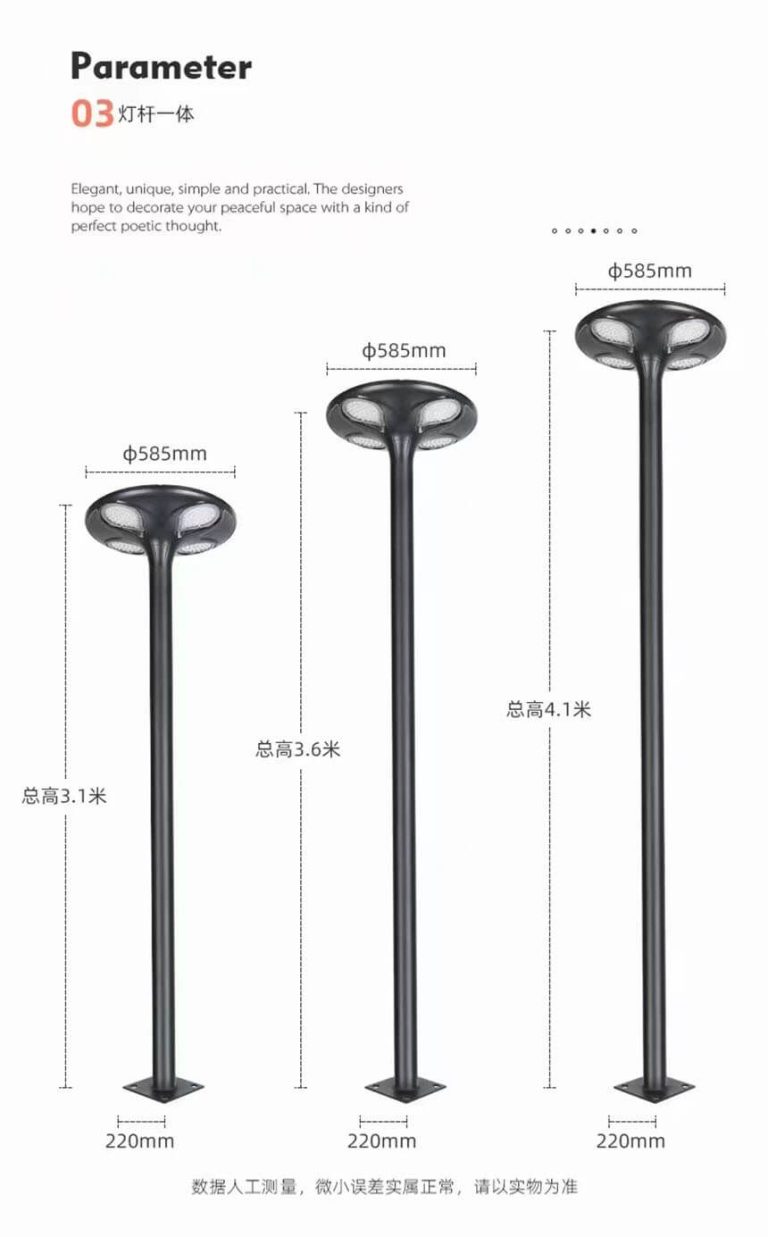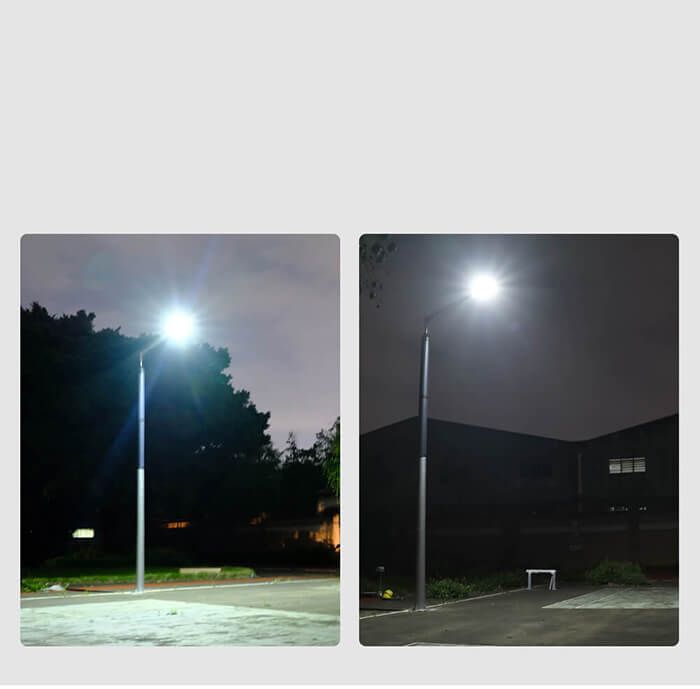Table of Contents
Advantages of Smart Split Type Solar-powered Street Lighting Fixtures
Smart Split type Solar-powered Street Lighting Fixtures, also known as Smart Integrated Solar-powered Street Lights, represent a significant advancement in outdoor lighting technology. These fixtures combine the efficiency of solar power with intelligent control systems to provide reliable and sustainable illumination for streets, pathways, and public spaces. In this article, we will explore the advantages of Smart Split type Solar-powered Street Lighting Fixtures and how they contribute to energy efficiency, cost savings, and environmental sustainability.

One of the primary advantages of Smart Split type Solar-powered Street Lighting Fixtures is their energy efficiency. By harnessing solar energy during the day, these fixtures charge their batteries, which power LED lights during the night. This eliminates the need for grid electricity, reducing reliance on fossil fuels and lowering carbon emissions. Additionally, the integration of smart control systems allows these fixtures to adjust their brightness levels based on ambient light conditions, further optimizing energy usage.
Moreover, Smart Split type Solar-powered Street Lighting Fixtures offer significant cost savings over their traditional counterparts. While the initial investment may be higher due to the integration of solar panels and advanced control systems, the long-term operational costs are substantially lower. Since these fixtures do not require electricity from the grid, there are no monthly utility bills to contend with. Additionally, maintenance costs are reduced as LED lights have a longer lifespan and require less frequent replacement compared to traditional bulbs.
Furthermore, the deployment of Smart Split type Solar-powered Street Lighting Fixtures contributes to environmental sustainability. By utilizing renewable energy sources such as solar power, these fixtures help reduce the carbon footprint associated with outdoor lighting. They also promote energy independence by reducing reliance on non-renewable resources. Additionally, the use of LED lights minimizes light pollution, preserving the natural nighttime environment and promoting biodiversity.
Another advantage of Smart Split type Solar-powered Street Lighting Fixtures is their versatility and ease of installation. These fixtures can be installed in a wide range of outdoor environments, including urban streets, parks, and remote rural areas. Their modular design allows for flexible placement and configuration, making them suitable for various lighting applications. Additionally, the integration of wireless communication capabilities enables remote monitoring and control, facilitating maintenance and troubleshooting.
Moreover, Smart Split type Solar-powered Street Lighting Fixtures enhance safety and security in public spaces. By providing reliable illumination, they help improve visibility and deter criminal activity. The integration of motion sensors and intelligent control systems further enhances security by activating lights when motion is detected and adjusting brightness levels as needed. This not only improves safety for pedestrians and cyclists but also enhances the overall sense of community well-being.
| Serial Number | Commodity Name |
| 1 | Solar Street Light |
In conclusion, Smart Split type Solar-powered Street Lighting Fixtures offer numerous advantages over traditional lighting solutions. From energy efficiency and cost savings to environmental sustainability and enhanced safety, these fixtures represent a smart and sustainable approach to outdoor lighting. By harnessing the power of the sun and integrating intelligent control systems, they provide reliable illumination while reducing reliance on non-renewable resources. As cities and communities continue to prioritize sustainability and efficiency, Smart Split type Solar-powered Street Lighting Fixtures will play a crucial role in shaping the future of outdoor lighting infrastructure.
How Smart Integrated Solar-powered Street Lights Enhance Urban Sustainability
In the pursuit of sustainable urban development, the integration of smart technologies has emerged as a pivotal strategy to enhance efficiency and minimize environmental impact. Among these innovations, smart integrated solar-powered street lights stand out as a promising solution to illuminate urban landscapes while reducing energy consumption and carbon emissions.
Traditionally, street lighting has relied heavily on grid-connected electricity, which can be both costly and environmentally taxing. However, the advent of solar-powered lighting has transformed this paradigm by harnessing the abundant energy of the sun to illuminate streets, pathways, and public spaces. Smart integrated solar-powered street lights take this concept a step further by incorporating advanced technologies to optimize performance and functionality.
One of the key features of smart integrated solar-powered street lights is their ability to operate autonomously, relying on a combination of photovoltaic panels, energy storage systems, and energy-efficient LED luminaires. These systems are designed to capture solar energy during the day and store it in batteries for use during the night, ensuring continuous and reliable illumination without the need for grid electricity.
Moreover, smart integrated solar-powered street lights are equipped with intelligent control systems that enable remote monitoring and management. Through connectivity options such as wireless communication and IoT (Internet of Things) protocols, municipalities and utility providers can remotely monitor the performance of each street light, adjust brightness levels, and detect malfunctions in real-time. This not only streamlines maintenance operations but also improves energy efficiency by optimizing lighting levels based on ambient conditions and pedestrian traffic patterns.
Furthermore, smart integrated solar-powered street lights contribute to enhanced safety and security in urban environments. By providing consistent and uniform illumination, they help to deter crime and improve visibility for both pedestrians and drivers, thereby reducing the risk of accidents and improving overall public safety.
In addition to their functional benefits, smart integrated solar-powered street lights also offer significant environmental advantages. By utilizing clean, renewable energy sources, they help to reduce greenhouse gas emissions and mitigate the impact of climate change. Moreover, their energy-efficient LED luminaires consume significantly less electricity than conventional street lights, further lowering carbon footprints and operational costs.
From a financial perspective, the deployment of smart integrated solar-powered street lights can lead to long-term savings for municipalities and utility providers. While the upfront costs of installation and equipment may be higher than traditional lighting systems, the reduced energy consumption and maintenance requirements offer substantial long-term cost savings. Additionally, many governments offer incentives and subsidies to encourage the adoption of renewable energy technologies, further offsetting initial investment costs.
In conclusion, smart integrated solar-powered street lights represent a cutting-edge solution to enhance urban sustainability by combining renewable energy, advanced technologies, and intelligent design. By reducing energy consumption, enhancing safety, and minimizing environmental impact, these innovative lighting fixtures are paving the way for a brighter and more sustainable future in our cities. As urban populations continue to grow and resources become increasingly scarce, investing in smart integrated solar-powered street lights is not just a wise choice but a necessary step towards building resilient and sustainable urban communities.





